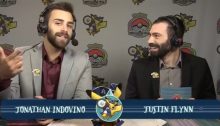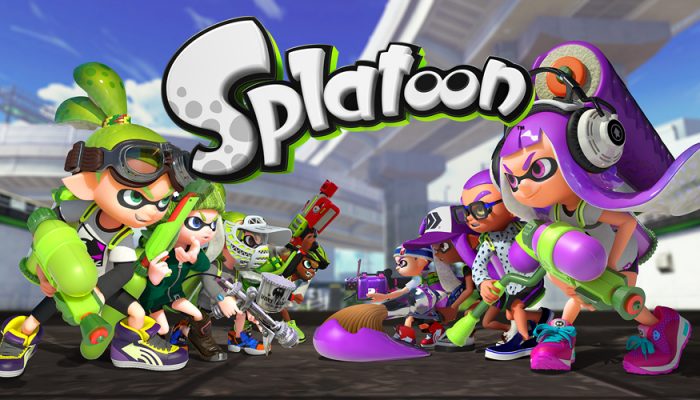 That Machamp though. All the Pokémon Worlds final-round battles are available on Twitch through this article.
That Machamp though. All the Pokémon Worlds final-round battles are available on Twitch through this article.
☆ NintendObs Weekly – Monday, September 7, 2015 – Sunday, September 13, 2015.
Japan Returns to the Top at Worlds!
We break down the 2015 Pokémon Video Game World Championships and how the Japanese players found renewed success.
The 2015 Pokémon Video Game World Championships showcased a wealth of talented players from around the world, putting on display an impressive demonstration of strategic play. But dominating all of them were the incredible players from Japan. The style of play that catapulted their return to dominance is worth a deeper look. The 2015 Pokémon World Championships also marked a return of Mega Kangaskhan after its disappointing performance in last year’s Worlds.
The Masters Division title went home with Japan’s National Champion, Shoma Honami, who, like many of the top Japanese players, built his team around Mega Kangaskhan. He became the first Video Game World Champion in the highest age division from Japan since 2009—two years before the Video Game Masters Division even existed. (Watch his final-round battle here.) He was joined by: six more Japanese players in the Masters Division top 8, the second place finisher in the Senior Division, and three of the top four Junior Division players.
The best finishers in the Masters Division this year seemed to follow similar strategies with their teams. As opposed to most recent Pokémon World Championships, the top players this year did not seek out unexpected Pokémon to defeat their opponents with the element of surprise. Nor did they train their teams to focus on having highly advantageous matchups with most of their opponents. Instead, the top Trainers this year chose strong, safe teams that rarely had large advantages or disadvantages against opposing teams. They brought teams that were flexible, using many powerful, durable Pokémon. Their plan was to make sure that no matter what they faced, they could come out on top if they played well enough.
The strategy of the Japanese players paid off, leaving the defeated Trainers conflicted about what happened. Did they focus on countering the wrong Pokémon? Were the players from Japan simply on a level the rest of the world wasn’t ready to compete with? Were the teams the Japanese players used just too powerful to handle?
The top-performing teams in the Masters Division featured mostly Pokémon that Trainers have used frequently all year, yet most competitors seemed surprisingly ill-equipped to handle them in Boston. The raw power of the top Pokémon, combined with brilliant play and some clever twists to the training of commonly used Pokémon, proved to be too much for the rest of the field to handle.
The Big Seven
The top eight teams in the Masters Division mainly consisted of seven particular Pokémon:
Pokémon
Usage in Top-8 Landorus 8 Amoonguss 6 Heatran 6 Kangaskhan 6 Cresselia 5 Thundurus 4 Aegislash 3 All Other Pokémon 10
With US Nationals fresh in players’ minds before the World Championships, many Trainers planned their teams around the top teams from Indianapolis (including international competitors who used its results for guidance). They reasoned that the biggest and most recent best-of-three Nationals tournament would be a sign of things to come. As such, Mega Kangaskhan may have flown under the radar with players predicting that other Mega-Evolved Pokémon, such as Mega Salamence and Mega Charizard Y, would be the biggest concerns at the 2015 Pokémon World Championships. Trainers may also have looked back to the 2014 World Championships, where Mega Kangaskhan was rendered ineffective by a field determined to prevent it from winning, and seen it as a risky choice. Whatever the reason, most Trainers deemed it less important to stack their teams against Mega Kangaskhan than other top Pokémon. Thus, the stage was set for teams based around Mega Kangaskhan to dominate.
Not only did Mega Kangaskhan appear on six of the top eight teams, it was also usually the focus of its team’s approach. These teams had other similarities: Landorus Therian Forme appeared on all six of these teams (and all eight of the teams in the Masters top 8), cementing its role as the most intimidating Pokémon in the format. Plus, Cresselia appeared on five teams, while Amoonguss and Heatran each appeared on four of the six teams where Mega Kangaskhan was present. Thundurus, Aegislash, and Mega Gardevoir were the only other Pokémon to appear on more than two teams in the Masters top cut. It should have come as little surprise that the Pokémon widely considered to be the most powerful were the most common at the World Championships.
Mega Kangaskhan had its usual cadre of supporting Pokémon that were well-suited to come out on top in the long, close battles of the World Championships. Mega Kangaskhan’s natural defensive sturdiness and devastating Parental Bond Ability made it a great fit for teams looking to maximize power. Trainers then sought ways to build a team around it. Since Mega Kangaskhan’s first appearance in Pokémon X and Pokémon Y, Amoonguss has been the most iconic partner for Mega Kangaskhan. Amoonguss’s excellent defensive stats combine well with the moves Rage Powder and Spore to protect Mega Kangaskhan, while its extremely low Speed helps its team face off against opposing Trick Room teams.
Landorus’s Therian Forme offers not only the Intimidate Ability many Trainers view as essential to include on every team, but also great move variety, stats, and typing. Thundurus works well on teams that don’t have many Pokémon with very high Speed, since the Paralysis inflicted by Thundurus’s Thunder Wave slows down the target below the Speed of those Pokémon anyway.
Cresselia’s dominant defensive presence helps balance teams, particularly combined with its immunity to Landorus’s Earthquake and access to Ice-type attacks. Cresselia also often grants its team access to Trick Room, which further troubles faster opponents.
Finally, Aegislash and Heatran have great defensive stats and typing, so they can dish out damage safely while giving their Trainers useful resistances to switch into dangerous attacks. Many Kangaskhan use Fake Out, which helps the two Steel-type Pokémon set up Substitutes. Aegislash’s incredible Ability, Stance Change, can enable it to effectively have both very high offensive and defensive stats as long as it only takes hits in its Shield Forme. Stance Change helps Aegislash compete in a field full of Legendary Pokémon that have higher stats than either of its Formes do individually.
Together, these Pokémon offer a variety of useful type resistances and offensive synergy. Trainers were able to select combinations of these Pokémon that held their own against any team that opposed them. The Japanese top players used the natural advantages of these Pokémon to overcome any crafty, metagame-centric approach that many other players used.
Tournament Tricks
The team compositions used in the Masters Division weren’t unknown to Trainers before the event. Shoma Honami even used five of the same six Pokémon to win both the Japanese National and World Championships: Cresselia, Heatran, Amoonguss, Landorus Therian Forme, and Mega Kangaskhan. The only roster change he made was in swapping out his Mega Charizard Y for Thundurus. But he also made many more impactful, if subtle, changes, including a variety of minor adjustments to his Pokémon’s moves, items, and training that added up to a major difference. Trainers saw what seemed to be a very mundane team composition during Team Preview, only to realize too late that it wasn’t really the same team they’d played against all year on Battle Spot.
While the Pokémon used were consistent across the top teams, each of them had quirks that opponents likely weren’t expecting or preparing for. One choice that stands out is many Japanese Trainers opting to teach Pokémon the move Protect. Western players normally choose not to use it. All four of the Thundurus in the Masters top cut in Boston knew Protect, while only one of the 16 Thundurus that made it to the second day of US Nationals were taught Protect. Even two of the five Cresselia, a Pokémon that has a huge number of viable moves Trainers can choose from, had learned Protect. Using Protect on the supportive Pokémon made it riskier for opponents to target them. Teaching Protect to more Pokémon also made it easier for Trainers to figure out which opposing Pokémon held Choice items and learn what moves they were locked into without first being hit.
For their own teams, Choice items were almost unseen. Only one Pokémon in the Masters top 8 held a Choice Scarf—a Tyranitar that was a member of Daiki Moriyama’s team, the only team without any Speed control moves. Western players had battled with and against Landorus holding Choice Scarf all year, which the top players at Worlds took advantage of. Aided by the prevalence of Protect, top players were able to find out what move Pokémon holding Choice items were locked into at a low cost, then make safe switches to take control of the game. The Landorus used by Japanese players holding items such as Assault Vest or Life Orb instead of Choice Scarf stayed effective longer than the Landorus we’d seen earlier in the year, and were even able to take advantage of Trick Room.
Six of the Masters Division top-8 teams used the disruptive move Trick Room as part of their strategy. Trick Room accentuates two big trends Trainers often build their teams around in the World Championships: defense and flexibility. A natural consequence of Trainers choosing to train their Pokémon mostly in defense and offense is that they are unable to train their Pokémon’s Speed. Trick Room dovetails with that approach to training nicely, turning that drawback into an advantage. Trick Room can even help fast Pokémon late in battles by reversing the effects of Speed control moves they may be afflicted with, such as Thunder Wave and Icy Wind.
Several other Pokémon at the World Championships used some uncommon moves to catch foes off-guard. Champion Shoma Honami’s Sunny Day Amoonguss was something we didn’t see much of earlier in the season, but it was an effective tool to boost his Heatran’s damage and defeat teams built around Politoed’s Drizzle. Two of the three Aegislash in the Masters Division top 8 knew Shadow Sneak, a rare move in tournament play, but it scored some important knockouts on low-health targets, proving powerful against unsuspecting targets. Three of the five Cresselia even used a Ground-type Hidden Power, dealing big damage to important Steel-type Pokémon, such as Heatran.
The VGC 2015 Format Continues
So how do players move forward into the 2016 season, including the upcoming Autumn Regional Championships? Even the best players in the west are asking that question. After the amazing performance by Japan, three-time World Champion Ray Rizzo asked some of the top Japanese players what they thought the best response to Landorus and Thundurus was. Their answer was simple: “There is no counter—you use your own Thundurus and Landorus.” In past seasons players were able to use a Choice Scarf or the move Trick Room to help Pokémon with Ice-type attacks get the jump on the powerful Legendary Pokémon; this year the group of Pokémon around them proved too powerful. With Pokémon X and Pokémon Y standouts like Mega Kangaskhan and Aegislash joining the top Pokémon of 2013, Trainers are still looking for reliable solutions to beat the teams that dominated Worlds.
The most successful Mega-Evolving Pokémon other than Mega Kangaskhan in the Masters Division was Mega Gardevoir. It was the only other Mega-Evolved Pokémon to appear in the top 8, showing up on two teams. Mega Gardevoir offered some variety, but one of its strengths is that it also pairs well with Landorus, Heatran, Amoonguss, and Thundurus. One player who did use Mega Gardevoir was Lajos Woltersdorf of Germany: he broke new ground for the Mega Gardevoir archetype, using a Hydreigon that knew Tailwind and a Wash Rotom that knew the rarely seen Electroweb to help control the field. Lajos managed an 8th place finish despite playing through a gauntlet of exclusively Japanese players in the Swiss rounds, with the sole exception being 2013 semi-finalist Aaron Zheng of the United States. It’s that kind of impressive finish that will give reason for other Trainers to look to build off his team’s direction. Mega Gardevoir was also the Mega-Evolving Pokémon of choice for Junior World Champion Kotone Yasue (watch her final battle here).
d Championships, looking to make only minor adjustments to give themselves advantages in near mirror matches. The item Safety Goggles was only used by a few players at the World Championships, including by World Champion Shoma Honami, but it can be very disruptive to teams relying on Amoonguss for protection. We saw some Landorus at US Nationals using an Ice-type Hidden Power, Earth Power, and Stone Edge, which seems to be another good fit for this sort of strategy. Looking forward, players will have to make similar tactical shifts to defeat teams like those we saw at Worlds.
One team that may be able to stand toe-to-toe with the top Masters Division finishers is the team used by Senior Division World Champion Mark McQuillan. His finals match featured a dominating display of Skill Swap, a move that troubles the many Ability-reliant Pokémon seen on the top teams. Mark’s surprise Pokémon, Machamp, also had a solid matchup against many common Pokémon, such as Thundurus and Heatran. Other top Fighting-type Pokémon, especially Conkeldurr that knows Ice Punch, are likely to be part of Trainers’ plans to fight back against Mega Kangaskhan teams.
With the format of the Video Game Championships lasting until at least the end of 2015, the 2015 Autumn Regionals will continue to use the format of the World Championships. For now, Mega Kangaskhan has shown it is once again the top Mega-Evolved Pokémon for Trainers to counter. Stay tuned to Pokemon.com/Strategy to find out how Trainers adapt to defeat it in upcoming events, as well as to find all of the most recent strategy content.
Source: Pokémon.
At NintendObserver, the comments are on Discord.
Click on Community to learn more. 🙂
…
And if you’ve already got yours, click on Pokémon Omega Ruby and Alpha Sapphire for everything you need to know about the games. 😀



